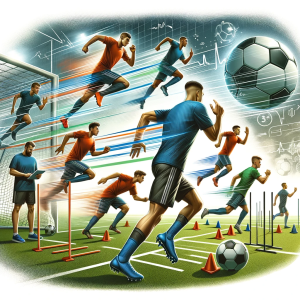
Understanding the Evolution of Soccer Performance
Soccer demands a high level of physical and technical skill from its players. A recent study titled The Soccer Season: Performance Variations and Evolutionary Trends comprehensively analyzes how professional players’ performance evolves throughout a soccer season. This blog aims to break down the complexities of this study into understandable insights for soccer enthusiasts and professionals alike, focusing on coaching and player development implications.
Key Findings
Body Composition and Neuromuscular Adaptations
- Body Composition: Players generally maintain or improve their body composition throughout the season, with decreases in body fat and increases in lean body mass.
- Neuromuscular Function: Improvements are observed in jump abilities and sprint performances, crucial for high-impact soccer actions.
Seasonal Variations in Performance
- Preseason: Significant improvements are noted in aerobic and anaerobic capacities. This phase is critical for building foundational fitness levels.
- In-Season: Slight improvements or maintenance of preseason gains are typical. However, the demanding match schedule often limits the scope for further physical development.
- End of Season: Some decline in aerobic capacities is observed, likely due to accumulated fatigue and less focus on physical training.
Implications for Training and Monitoring
- Customized Training: Tailoring training programs to individual player needs and seasonal phases is vital. Emphasis on neuromuscular training and maintaining aerobic fitness throughout the season is crucial.
- Training Monitoring: Regular assessment of players’ physical and physiological parameters helps in optimizing training and preventing overtraining or injury.
- Recovery Strategies: Implementing effective recovery protocols is as crucial as training, especially during congested fixture periods.
Evolutionary Trends in Soccer
- The study also highlights an evolutionary trend towards a greater importance of neuromuscular factors in modern soccer. This suggests a shift in training focus towards enhancing power and speed.
Practical Application in Coaching and Player Development
Coaching Strategies
- Periodization: Coaches should focus on building aerobic and anaerobic capacities in the preseason and work on maintaining these levels throughout the season.
- Individualized Focus: Recognizing the varying needs of players throughout the season and tailoring training accordingly can optimize performance.
- Tactical Training: As physical aspects are maintained, coaches can focus more on tactical and skill-based training during the season.
Player Development
- Holistic Development: Players should focus on all aspects of fitness – strength, endurance, agility, and technical skills.
- Continuous Monitoring: Regular fitness assessments help players understand their physical state and guide their training needs.
- Off-Season Training: Maintaining a baseline fitness level during the off-season can lead to better pre-season adaptations.
Conclusion
Coaches and players can utilize this information to optimize training, enhance performance, and develop more effective season-long strategies. The evolution of soccer demands a dynamic approach to training, where adaptability and personalized planning are key.



